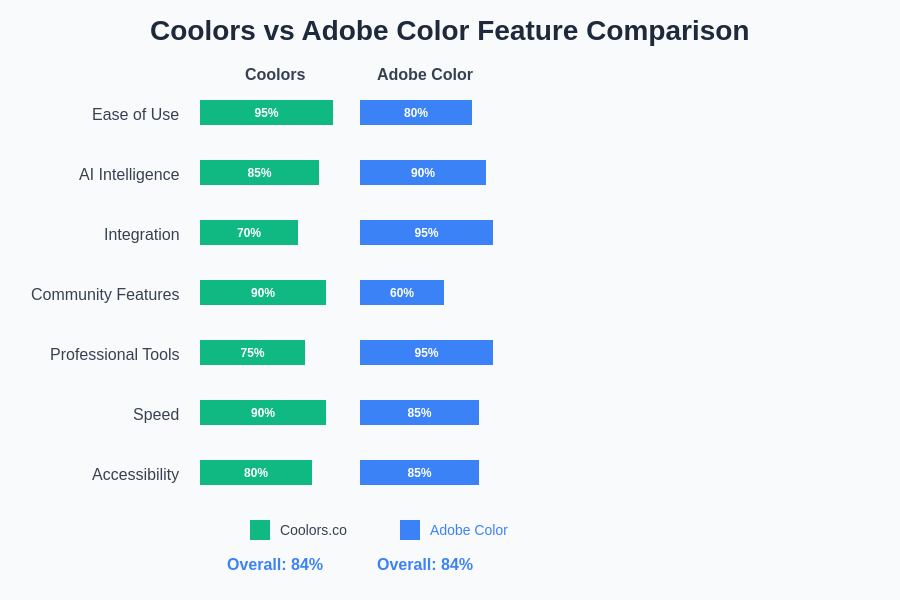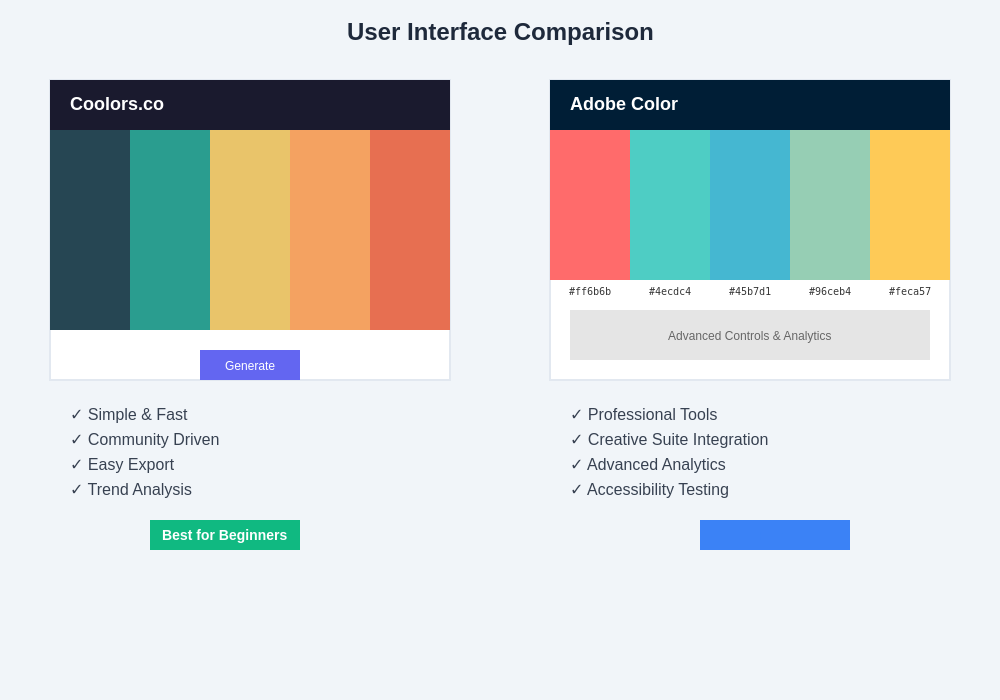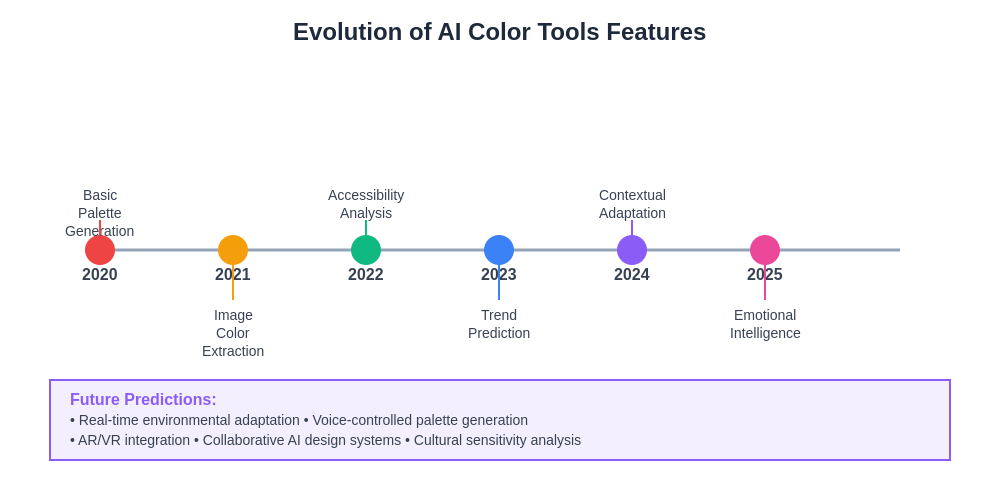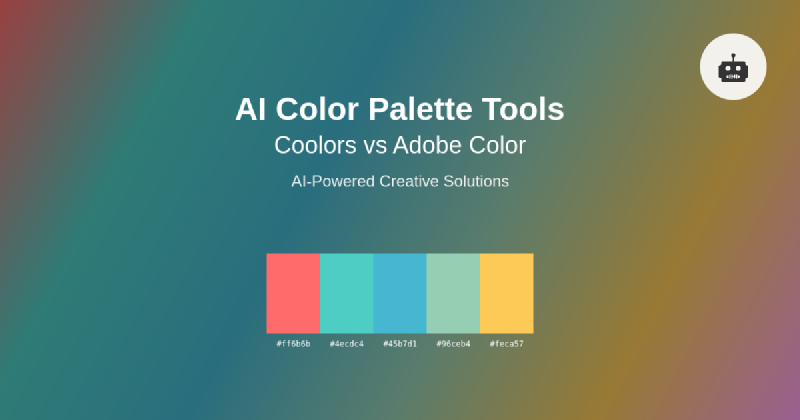The world of digital design has been revolutionized by artificial intelligence, particularly in the realm of color palette generation where sophisticated algorithms now assist designers in creating harmonious and visually striking color combinations. Among the most prominent tools in this space are Coolors and Adobe Color, both leveraging AI capabilities to transform how designers approach color selection and palette creation. These platforms represent the cutting edge of AI-powered design assistance, offering unique approaches to solving one of the most fundamental challenges in visual communication.
Explore the latest AI design trends to discover how artificial intelligence is reshaping creative workflows and opening new possibilities for designers across various disciplines. The evolution of AI-powered color tools has democratized access to sophisticated color theory principles while maintaining the creative control that professional designers demand in their workflow.
The Evolution of AI-Powered Color Selection
Traditional color selection methods required extensive knowledge of color theory, psychology, and design principles that took years to master. Modern AI-powered tools have transformed this landscape by incorporating machine learning algorithms trained on millions of successful design combinations, enabling both novice and experienced designers to generate professional-quality palettes with unprecedented speed and accuracy. These tools analyze color relationships, contrast ratios, accessibility standards, and aesthetic principles to suggest combinations that would traditionally require deep expertise to achieve.
The sophistication of contemporary AI color tools extends beyond simple palette generation. These platforms now incorporate contextual understanding of design trends, cultural color associations, brand identity requirements, and user preferences to deliver highly personalized and relevant color suggestions. This evolution has created a new paradigm where AI serves as an intelligent collaborator rather than a replacement for human creativity, amplifying design capabilities while preserving the essential human elements of artistic vision and strategic thinking.
Coolors: The Community-Driven AI Platform
Coolors has established itself as one of the most popular AI-powered color palette generators, combining algorithmic sophistication with community-driven features that create a rich ecosystem of color inspiration. The platform utilizes advanced machine learning models trained on vast datasets of successful color combinations from professional designs, user-generated content, and color theory principles to generate palettes that are both aesthetically pleasing and functionally effective for various design applications.
The platform’s AI engine incorporates multiple approaches to palette generation, including complementary color theory, analogous relationships, triadic harmonies, and split-complementary schemes. What sets Coolors apart is its ability to learn from user interactions, continuously improving its suggestions based on which palettes receive positive feedback from the design community. This crowd-sourced learning approach has resulted in an AI system that not only understands technical color relationships but also captures contemporary aesthetic preferences and emerging design trends.
Experience advanced AI capabilities with Claude for comprehensive design analysis and creative project development that goes beyond color selection to encompass entire design strategies. The integration of multiple AI tools creates a powerful workflow that enhances every aspect of the creative process from initial concept to final implementation.
Adobe Color: Professional-Grade AI Integration
Adobe Color represents the professional tier of AI-powered color tools, seamlessly integrated into the broader Adobe Creative Suite ecosystem. The platform leverages Adobe’s extensive research in color science, machine learning, and design psychology to provide sophisticated palette generation capabilities that meet the demanding requirements of professional designers and creative agencies. Adobe’s AI models are trained not only on color theory but also on real-world usage data from millions of Creative Cloud users worldwide.
The platform’s AI capabilities extend beyond basic palette generation to include intelligent color extraction from images, accessibility analysis, trend prediction, and brand color optimization. Adobe Color’s machine learning algorithms can analyze uploaded images to extract dominant colors, identify mood and emotional associations, and suggest complementary palettes that maintain visual harmony while serving specific design objectives. This contextual intelligence makes Adobe Color particularly valuable for projects requiring precise color matching and professional-level accuracy.
Feature Comparison and Capabilities Analysis
The functional differences between Coolors and Adobe Color reveal distinct approaches to AI-powered color generation, each optimized for different user needs and workflow requirements. Coolors excels in rapid palette generation, community engagement, and accessibility for users across all skill levels. Its AI algorithms prioritize speed and variety, enabling users to quickly explore numerous color combinations and discover unexpected palette possibilities through its intuitive interface.
Adobe Color focuses on precision, integration, and professional workflow optimization. Its AI systems are designed to support complex design projects requiring exact color matching, brand consistency, and technical accuracy. The platform’s integration with other Adobe tools enables seamless color workflow management across multiple applications, while its AI-powered analysis tools provide detailed insights into color psychology, accessibility compliance, and trend alignment that inform strategic design decisions.

The comparative analysis reveals that while both platforms utilize advanced AI algorithms, their implementation strategies reflect different design philosophies and target audiences. Coolors emphasizes creative exploration and community-driven discovery, while Adobe Color prioritizes professional accuracy and workflow integration. The quantitative comparison demonstrates that each platform excels in different areas, making the choice dependent on specific user requirements and workflow priorities.
AI Algorithm Approaches and Methodologies
The underlying AI methodologies employed by these platforms represent different approaches to machine learning in creative applications. Coolors utilizes a combination of generative adversarial networks and collaborative filtering algorithms that learn from user behavior patterns and community preferences. This approach enables the platform to generate palettes that not only follow color theory principles but also align with contemporary aesthetic trends and user preferences discovered through collective intelligence.
Adobe Color implements a more structured approach using deep learning models trained on curated datasets of professional design work, color theory principles, and empirical research in color psychology. The platform’s AI systems incorporate rule-based constraints derived from design best practices while utilizing neural networks to explore creative possibilities within those parameters. This hybrid approach ensures that generated palettes meet professional standards while still offering creative flexibility and innovation potential.
User Experience and Interface Design
The user experience design of AI color tools significantly impacts their effectiveness and adoption among different user segments. Coolors has prioritized simplicity and immediate accessibility, creating an interface that enables rapid palette generation and exploration without requiring extensive learning or setup. The platform’s AI works invisibly in the background, presenting users with intuitive controls and instant feedback that makes color selection feel natural and effortless.
Adobe Color adopts a more comprehensive approach that balances accessibility with professional feature depth. The interface provides immediate access to basic palette generation while offering advanced controls for users who require precise color manipulation and analysis. The AI features are thoughtfully integrated into the workflow, providing intelligent suggestions and automated analysis without overwhelming users with unnecessary complexity or technical jargon.

The interface design philosophy of each platform reflects their respective target audiences and use cases, with Coolors optimizing for creative exploration and Adobe Color focusing on professional workflow efficiency. The visual comparison highlights the distinct approaches to user experience, demonstrating how interface design directly impacts the effectiveness of AI-powered color generation tools.
Enhance your research capabilities with Perplexity to dive deeper into color theory, design psychology, and emerging trends that inform effective palette selection strategies. Access to comprehensive research tools enables designers to make informed decisions based on current market insights and psychological research.
Practical Applications in Design Workflows
The integration of AI color tools into practical design workflows has transformed how designers approach color selection across various disciplines. In web design, these platforms enable rapid prototyping of color schemes that consider accessibility requirements, brand guidelines, and user experience principles simultaneously. The AI algorithms can analyze existing design elements and suggest palettes that maintain visual hierarchy while enhancing overall aesthetic appeal.
Brand identity development has particularly benefited from AI-powered color analysis, where tools can evaluate proposed color palettes against psychological associations, cultural considerations, and competitive landscape analysis. These platforms can identify color combinations that effectively communicate brand values while ensuring distinctiveness in crowded market spaces. The ability to rapidly generate and evaluate multiple palette options has accelerated the brand development process while improving the strategic foundation of color choices.
Mobile and Cross-Platform Accessibility
The mobile optimization of AI color tools has become increasingly important as designers work across multiple devices and contexts. Coolors has developed robust mobile applications that maintain full AI functionality while optimizing the interface for touch interaction and smaller screen formats. The platform’s AI algorithms are specifically tuned to work effectively within mobile constraints, ensuring that palette generation remains fast and accurate regardless of device capabilities.
Adobe Color’s mobile implementation focuses on seamless synchronization with desktop workflows, enabling designers to capture color inspiration on mobile devices while maintaining access to full AI analysis features. The platform’s AI systems can process images captured on mobile devices to extract color palettes that are immediately available across all connected Adobe applications, creating a unified color workflow that spans multiple devices and use contexts.
Integration Capabilities and Workflow Optimization
The ecosystem integration capabilities of AI color tools significantly impact their value in professional design workflows. Coolors has developed extensive integration options with popular design software, enabling designers to export AI-generated palettes directly into their preferred applications. The platform’s API allows for custom integrations that can incorporate AI color generation into specialized workflows and proprietary design tools.
Adobe Color’s integration advantages stem from its native connection to the Creative Suite ecosystem, where AI-generated palettes automatically synchronize across Photoshop, Illustrator, InDesign, and other Adobe applications. This seamless integration eliminates manual color transfer processes while ensuring consistency across multiple design elements and projects. The AI system can analyze colors used across different applications to suggest harmonious palettes that work effectively across various media and output formats.
Advanced AI Features and Future Capabilities
The advanced AI features available in modern color tools represent significant innovations in computational creativity and design assistance. Coolors has implemented machine learning models that can analyze design trends across social media platforms, identifying emerging color preferences and aesthetic movements before they become mainstream. This predictive capability enables designers to create palettes that anticipate future trends while maintaining current relevance.
Adobe Color’s advanced AI features include emotional analysis algorithms that can evaluate the psychological impact of color combinations and suggest modifications to achieve specific emotional responses. The platform’s machine learning systems can analyze brand perception data to recommend color palettes that optimize for desired brand associations while maintaining visual appeal and practical functionality across various applications.

The continuous evolution of AI capabilities in color tools promises even more sophisticated features including contextual adaptation, personalized learning, and collaborative intelligence that enhances team-based design processes. This timeline illustrates the rapid advancement of AI features in color tools, with future developments promising even more intuitive and context-aware design assistance.
Performance Metrics and Accuracy Assessment
Evaluating the performance of AI color tools requires consideration of multiple metrics including generation speed, aesthetic quality, color harmony accuracy, and user satisfaction. Coolors demonstrates exceptional performance in rapid palette generation, typically producing high-quality color combinations within seconds while maintaining consistency with established color theory principles. The platform’s AI algorithms show particular strength in creating palettes that resonate with contemporary aesthetic preferences and social media trends.
Adobe Color excels in technical accuracy and professional-grade color matching, with AI systems that can achieve precise color reproduction across different media and output formats. The platform’s performance metrics indicate superior accuracy in color accessibility analysis, brand color matching, and cross-platform consistency. These capabilities make Adobe Color particularly valuable for projects requiring exact color specifications and professional-level quality control.
Cost Analysis and Value Proposition
The economic considerations of AI color tools vary significantly based on user needs, usage patterns, and integration requirements. Coolors offers a freemium model that provides substantial AI-powered features at no cost, making advanced color generation accessible to students, freelancers, and small businesses with limited budgets. The platform’s premium features focus on enhanced organization, collaboration tools, and extended export options that provide clear value for professional users.
Adobe Color’s value proposition centers on ecosystem integration and professional-grade capabilities that justify its position within the Creative Suite subscription model. For users already invested in Adobe’s ecosystem, the AI color tools represent significant added value with no additional cost. The platform’s professional features, accuracy, and integration capabilities provide clear return on investment for design agencies and corporate creative teams.
Security and Privacy Considerations
Data privacy and security have become critical considerations for AI-powered design tools, particularly regarding user-generated content and design intellectual property. Coolors has implemented comprehensive privacy policies that protect user palette data while enabling the community features that enhance the AI learning process. The platform allows users to control the privacy settings of their created palettes while maintaining anonymous usage data that improves AI performance.
Adobe Color operates within Adobe’s enterprise-grade security framework, providing professional-level data protection and privacy controls. The platform’s AI systems process user data in compliance with international privacy regulations while maintaining the security standards required by enterprise clients. Advanced privacy features enable users to control how their design data is used in AI training processes while benefiting from improved algorithmic performance.
Industry Impact and Design Evolution
The widespread adoption of AI color tools has fundamentally altered the landscape of professional design, democratizing access to sophisticated color theory knowledge while accelerating design workflows across multiple industries. These platforms have lowered barriers to entry for aspiring designers while providing experienced professionals with powerful tools for exploration and optimization. The result has been an overall elevation in design quality across digital media as more creators gain access to professional-level color selection capabilities.
The impact extends beyond individual design improvement to influence broader aesthetic trends and design standardization. AI algorithms trained on successful design combinations have identified patterns and preferences that inform contemporary design movements, creating feedback loops that shape both current aesthetics and future design evolution. This computational influence on design culture represents a new paradigm where artificial intelligence actively participates in the creative process rather than simply supporting it.
Future Developments and Emerging Trends
The future evolution of AI color tools promises even more sophisticated capabilities including contextual adaptation, emotional intelligence, and predictive design assistance. Emerging technologies such as computer vision integration will enable AI systems to analyze environmental contexts and suggest palettes optimized for specific viewing conditions and audience demographics. Advanced machine learning models will incorporate real-time trend analysis, cultural sensitivity assessment, and personalized preference learning to deliver increasingly relevant and effective color recommendations.
The integration of AI color tools with emerging technologies such as augmented reality, virtual reality, and Internet of Things devices will create new opportunities for contextual color selection and adaptive design systems. These developments will enable color palettes that respond dynamically to environmental conditions, user preferences, and real-time data inputs, representing a fundamental shift from static color selection to intelligent, responsive design systems.
The continued advancement of AI in creative applications will likely result in more collaborative relationships between human designers and artificial intelligence, where AI systems serve as intelligent partners rather than simple tools. This evolution will require designers to develop new skills in AI collaboration while maintaining their essential roles in creative strategy, cultural interpretation, and aesthetic innovation that remain uniquely human capabilities.
Disclaimer
This article is for informational purposes only and does not constitute professional design advice. The views expressed are based on current understanding of AI color tools and their capabilities in design workflows. Readers should evaluate these tools based on their specific requirements and conduct their own testing before making professional decisions. Tool capabilities, pricing, and features may change over time, and effectiveness may vary depending on individual use cases and design objectives.
